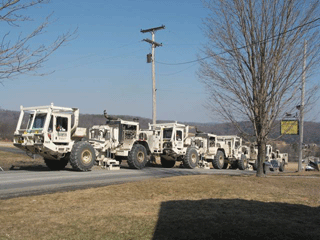Seismic testing
From Wikimarcellus
←Older revision | Newer revision→

down a country road near Springville, PA
Courtesy of Peter Comly, - Clodhopper Farm
Seismic testing (aka seismic mapping or surveying) is a technology used to search for pockets of natural gas. Typically, high tech vibroseis or vibrator trucks crawl along rural roads of Appalachia and send seismic waves into the surrounding ground in order to discover geologic formations under fields, farms and homes. Heliportable equipment, that is seismic equipment dropped from helicopter, although less commonly employed, is also used in seismic mapping.
A typical seismic survey in a forest preserve was described this way:
Workers clear the vegetation and mulch down 4 ft. wide paths in a grid pattern throughout the woods being surveyed. Microphones are then connected via bright orange cables along the paths. Vibrator units mounted on buggies emit sound waves that go approximately five miles down into the ground. These waves reflect back off of underground rock formations, and are picked up by the microphones. The seismic data produced is then studied in order to decide where to drill.
A second form of seismic testing consists of detonating small explosive charges in the ground. Generally the testing crew lays out a grid. Shot points that have small explosive devices in them are aligned in one direction, and receiver cables connected to geophones go the other way. When the explosions are detonated they are 20-30 feet in the ground and generate seismic waves that can be picked up by the geophones. Ususally about one hundred shot points are used per square mile. When permission to test can't be obtained, the crew works around the parcel in question. However, higher resolution imagery results when more shots can be made in the area being surveyed.
Both the viboseis method and setting off charges in the ground make use of the resulting soundwave data to render images of the rock formations below.
Seismic data can be used to computer generate or render 2-D and 3-D maps of the underlying rock formations up to a depth of 30,000 feet. A skilled analyst can gain some idea of the likelihood of finding gas in a particular area by reading these maps.
The conventional wisdom on seismic testing is that it won’t tell you exactly which locations to drill, but may help you figure out where not to. When horizontal drilling is to be employed, a good location for drilling is one that doesn't go across skips or faults. Such rock features can often be detected through seismic testing.

